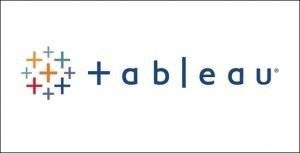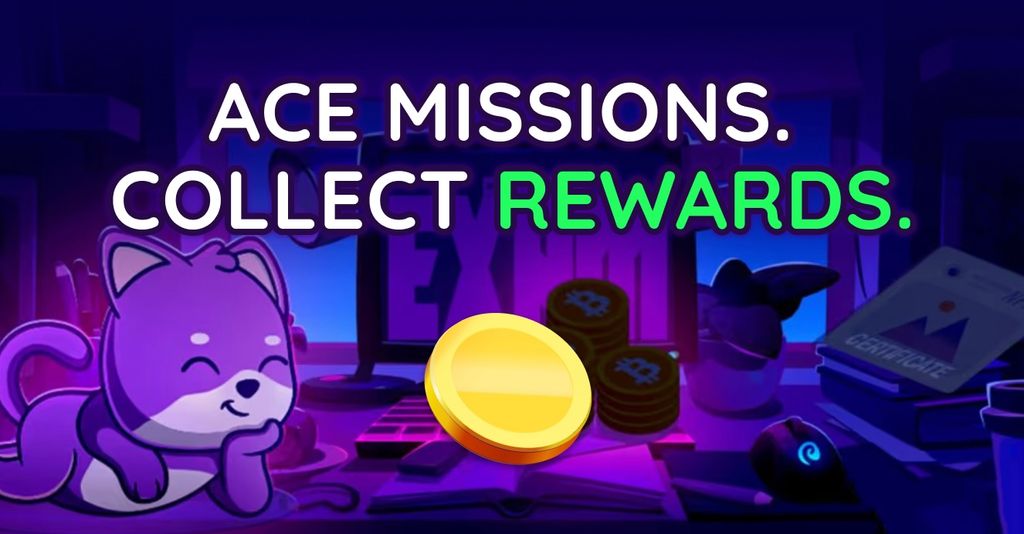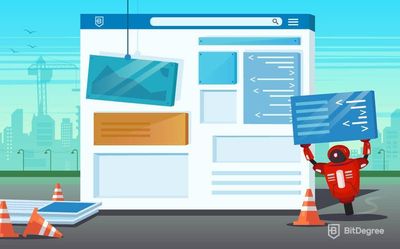Free Airdrop Season 7 is LIVE! Answer fun questions or do simple tasks to earn rewards from the $30K BitDegree prize pool. Participate Now ! 🔥
 If you work with data, yet lack tools to create great data visualization - Tableau is the tool that you’re looking for. It’s one of the most popular tools that both individuals and companies use to visualize their gathered data. Individuals need to constantly improve their knowledge so that their projects could stay up to date, while companies are looking for professional Tableau developers.
If you work with data, yet lack tools to create great data visualization - Tableau is the tool that you’re looking for. It’s one of the most popular tools that both individuals and companies use to visualize their gathered data. Individuals need to constantly improve their knowledge so that their projects could stay up to date, while companies are looking for professional Tableau developers.
If you’re passionate about working with data and want to score a job at one of the highest-paying companies, you’ll need Tableau interview questions and answers to help you study.
This guide will provide you with some of the most popular and essential information which you’ll be able to use while studying for that job interview.
Table of Contents
- 1. Basic Tableau Software Questions
- 1.1. Question 1: What is Tableau?
- 1.2. Question 2: Define ‘data visualization’.
- 1.3. Question 3: Name the main products of the Tableau company.
- 1.4. Question 4: What’s a ‘page shelf’?
- 1.5. Question 5: What are ‘hierarchies’ used for?
- 1.6. Question 6: Can you automate reports in Tableau?
- 1.7. Question 7: What’s a dimension?
- 1.8. Question 8: What is the benefit of using ‘extract a file’?
- 1.9. Question 9: In what situations would you use ‘Join’ and ‘Blending’?
- 1.10. Question 10: How many tables can you join together in Tableau?
- 1.11. Question 11: What is the difference between Traditional Business Intelligence (BI) and Tableau?
- 1.12. Question 12: What datatypes does Tableau support?
- 1.13. Question 13: What are the sets?
- 1.14. Question 14: What are the groups in Tableau?
- 1.15. Question 15: What is the difference between .twb and .twbx extension?
- 2. The Advanced Tableau Interview Questions
- 2.1. Question 1: Describe ‘data modeling’.
- 2.2. Question 2: What is the highest amount of rows that Tableau can utilize at any given time?
- 2.3. Question 3: What’s the use of a ‘secondary axis’?
- 2.4. Question 4: Can you test performance with Tableau?
- 2.5. Question 5: Why would you alter the parameters in Tableau?
- 3. Conclusions
Basic Tableau Software Questions
When it comes to the basic questions, these are the ones that you’ll probably encounter the most. A lot of companies have special “new employee training programs”. These are designed to help you get a smooth start in the company. This doesn’t only concern your working conditions, though! The training programs are most likely going to heavily consist of Tableau-related courses and lessons. This is why you’re probably going to mostly get asked basic Tableau interview questions during your job interview (unless you’re aiming for the high-tier positions).
Latest Deal Active Right Now:Follow the Datacamp promo code link & get an exclusive 25% OFF Datacamp subscriptions. Act now while the offer is still available!
A lot of people neglect the basic questions. They think that they already know all of the ins and outs of Tableau basics, and there’s nothing new to learn or revise. Well, these people usually learn the hard way - they get asked a simple question during their interview and, since they haven’t revised it, they stutter and only make things worse for themselves. Even though you might think that you know everything there is to know about the basics of Tableau, it is still a good idea to come freshly prepared - it might be tougher to define a simple concept than you think!
All in all, once you finish going through these basic Tableau interview questions, you’ll have a pretty well-painted picture of the types of questions you might expect during the actual interview. So, without further ado, let’s get straight into it.
Question 1: What is Tableau?
You’re probably not surprised by seeing this as the very first question on the list. And, truth be told, you shouldn’t be - out of all of the interview questions that might get asked the first, this is the most likely one.
This question is important. It will set the mood for the rest of the interview - employers often use it to check how well you can employ your definitions when it comes to talking about and defining broader terms. A lot of people see this question, go to Google, read off a generic, technical term-ridden answer and then simply recite it during their interview. In such cases, employers often ask in Tableau interview questions the potential employee to forget all of that fancy talk and just define it in their own words, which they then often fail to do. It is crucial not only to know what it is but to explain it in your terms.
A Short PSA
If you come to your job interview and tell your potential employers about Tableau in a unique, original way that they haven’t heard before - great! You probably just left a long-lasting impression about yourself, and the course of the interview should be pretty decent from here on out. Your interviewers will see that you are capable of forming your thoughts and then expressing them clearly and concisely. This will lead to them immediately developing a certain sense of respect for your knowledge, which can go a very long way when you’re securing that job position after the Tableau interview questions.
With that PSA out of the way, let’s get back to the actual question - what is Tableau?
When people say Tableau, they often refer to the software and not the company. In this tutorial, “Tableau” will also be used to talk about the program, unless stated otherwise.
Tableau is a piece of software created by a company of the same name in Washington, US. This software is concerned with data visualization - it allows developers to visually represent the data and information that they collect. This way, it makes the process of studying the data metrics and drawing conclusions a much easier and smoother process.
Question 2: Define ‘data visualization’.
This may as well be one of the very first Tableau interview questions that your potential employers ask you. Since this is the core concept behind Tableau, it is essential that you would not only know what it is, but also what are the purposes for its use.
Data visualization refers to a method of presenting collected data in a visually appealing manner. This would usually include lines, tables and everything in between. It is widely known and recognized that the information that is presented in this way is much more approachable and easy to take into when you’re trying to analyze it. Data visualization allows you to avoid confusion and various uncertainties when analyzing bigger chunks of information.
Question 3: Name the main products of the Tableau company.
Although this doesn’t look like one of the Tableau interview questions, your answer would truly be a dead giveaway of just how much you’ve studied before the interview. If you don’t know the products that Tableau offers, this means that you’re most likely concerned with only specific, niche topics and lack a thorough comprehension of Tableau.
In total, there are five main products that Tableau offers: Tableau Desktop, Server, Reader, Online and Public. Each of these products is targeted at different audiences (i.e. individuals vs companies) and performs different functions needed for better data visualization.
- Tableau Desktop. It is self-service business analytics and data visualization. It is used to translate pictures into data-optimized queries. By importing data into Tableau data engine you can integrate different sources and view it in an interactive dashboard.
- Tableau Server. It allows publishing multiple dashboards and sharing it through the organization's web-based Tableau server.
- Tableau Online. A hosted version of Tableau Server. It is used to make business intelligence faster and easier to use.
- Tableau Reader. An application that is used to view visualizations that are built-in Tableau Desktop.
- Tableau Public. A free Tableau software that is used to make visualizations, which have to be saved in worksheets in the Tableau Server.
Question 4: What’s a ‘page shelf’?
One of the most commonly found Tableau interview questions across all platforms. A page shelf is a tool that Tableau uses to control the visual outputs of your data. It is a widely used and appreciated tool, mostly because of its very user-friendly and useful when it comes to data visualization.
Question 5: What are ‘hierarchies’ used for?
Hierarchies offer a way to segment and organize your information into levels. Tableau does this by assigning a different value to each data type. This allows you to have more control over what you see and increases the accuracy of the visualization of the data.
Since this is one of the Tableau interview questions that allow you to expand a little bit with your answer, you could give an example of hierarchies - just to make sure that your interviewers know that you know what you’re talking about. A great example could be “Doberman - Dog - Animal”. There is a clearly defined segmentation in this example.
Question 6: Can you automate reports in Tableau?
Yes. You do so by scheduling them before publishing. Scheduling requires only a date - once you set that, your reports will be published automatically on the set date.
Question 7: What’s a dimension?
Easily one of the simpler Tableau developer interview questions - a dimension is a field that has an assigned, dedicated value. These can be text fields, dates, and so on.
Question 8: What is the benefit of using ‘extract a file’?
Most of the time, developers use a live connection when working on their Tableau projects. However, extracting a file allows you to work on it without a need for a stable internet connection.
Question 9: In what situations would you use ‘Join’ and ‘Blending’?
Both of these commands are used by Tableau developers, so you'll likely receive this as one of your Tableau interview questions. Fortunately, however, it is quite a simple one to answer and explain correctly.
Both of the commands are used to connect a primary data source to a secondary one. In situations where your data is located in a single location, you would always want to use Joins. However, if the data is scattered through multiple different locations, you would then most likely want to use Blending.
Question 10: How many tables can you join together in Tableau?
The absolute maximum number of tables that can be joined together in Tableau is 32.
Question 11: What is the difference between Traditional Business Intelligence (BI) and Tableau?
This is one of the tricky Tableau interview questions since it requires knowledge on both of the software. The main difference between Traditional BI and Tableau is that Tableau does not have dependencies like BI. It is based on Associative search which is dynamic and fast, unlike Traditional Business Intelligence which is based on a complex set of technologies. Tableau supports in-memory computing while working with advanced technologies and uses predictive analysis for various operations.
Question 12: What datatypes does Tableau support?
Tableau Software supports Boolean True / False, data and time values, geographical mapping, whole numbers, text or string values, and decimal numbers.
Question 13: What are the sets?
Sets are custom fields that define a subset of data based on some conditions. Alternatively, a set can be based on a specific data point in your view.
Question 14: What are the groups in Tableau?
A group is a combination of dimension members that make higher-level categories.
Question 15: What is the difference between .twb and .twbx extension?
A .twb is an XML document that contains all the selections and layout made you have made in your Tableau Workbook. It does not contain any data.
A .twbx is a ‘zipped’ archive containing a .twb and any external files such as extracts and background images.
The Advanced Tableau Interview Questions
Now that you know what to expect out of your job interview, we can step away from the basic questions and answers and move on to the more advanced ones.
Advanced questions on Tableau are there to check just how well you know the software and all of its components. Unless you’re trying to get hired as a Tableau expert, your employers are most likely not going to bombard you with a lot of these advanced level queries.

In nature, they are very similar to their basic counterparts. The only different thing is that to answer the advanced questions, you’ll have to have a pretty good comprehension of Tableau and all of its intricacies.
Below you’ll find 5 examples of the most commonly asked advanced Tableau interview questions. Study them well, and you should do great in your job interview!
Question 1: Describe ‘data modeling’.
Statistically speaking, data modeling is mostly used by businesses as opposed to individual developers). It is a process that aims to analyze the given data and find patterns (relationships) within it.
That is why it’s so popular with businesses. Analyzing customer data and finding certain patterns can help a business create and target ads, modify their product creation and so on. It is an essential feature of any successful business, both individual and enterprise-level.
Additionally, data modeling is the very first step that developers take when they are working with object-oriented programming.
Question 2: What is the highest amount of rows that Tableau can utilize at any given time?
If you’re thinking about a specific number, hold that thought - it’s already wrong!
When it comes to rows in the Tableau interview questions, it can utilize an unlimited number of them. This is because of a couple of reasons. First of all, the rows do not take up a lot of space - they are comparatively minuscule. Additionally, Tableau is configured in a way to only load and display the rows that are needed at that specific time and situation. This way, it lowers the encumbrance of the platform even more.
Question 3: What’s the use of a ‘secondary axis’?
Secondary axes almost exclusively serve a single purpose - to help you quickly analyze your data.
A secondary axis is usually added near the primary one. It offers additional specificity when analyzing and comparing data.
Question 4: Can you test performance with Tableau?
You could go and say that this is one of the trickier Tableau interview questions, since answering it wrong would probably show your employers that you do lack knowledge and experience with Tableau.
Why is that, you might say? Well, basically because performance testing is one of the most important features of Tableau. It can be done by downloading a Tableau plugin (TabJolt) and running your script with it.

- Easy to use with a learn-by-doing approach
- Offers quality content
- Gamified in-browser coding experience
- Free certificates of completion
- Focused on data science skills
- Flexible learning timetable

- High-quality courses
- Nanodegree programs
- Student Career services
- Nanodegree programs
- Suitable for enterprises
- Paid certificates of completion

- A wide range of learning programs
- University-level courses
- Easy to navigate
- University-level courses
- Suitable for enterprises
- Verified certificates of completion
Question 5: Why would you alter the parameters in Tableau?
Tableau has specific set parameters that it uses in every single operation that it performs. Naturally, if you’re a Tableau developer, there are going to be multiple scenarios where the data that you have to analyze will have some very inconsistent variables. In these situations, you would tamper with the default parameters to match the ones needed to successfully analyze the data.

Did you know?
Have you ever wondered which online learning platforms are the best for your career?
Conclusions
A lot of companies are looking for Tableau developers who would be great at teamwork, problem-solving and using Tableau itself. These companies are ready to pay great salaries and offer amazing career opportunities for such developers.
That is why you must not forget to be yourself during the job interview. If you show that you’re motivated and are great at working with a team, your potential employers might dismiss some of the Tableau interview questions that you failed to answers and ask you to join the company.

If you’re just starting to learn Tableau and are only looking at these questions to get an idea of what the future holds - great! It’s better to start learning ASAP. This way, you’ll be able to not only give yourself some time but also find out the essentials that are going to be needed to get that job. Be sure to check other tutorials and courses that might be helpful in your further career.








